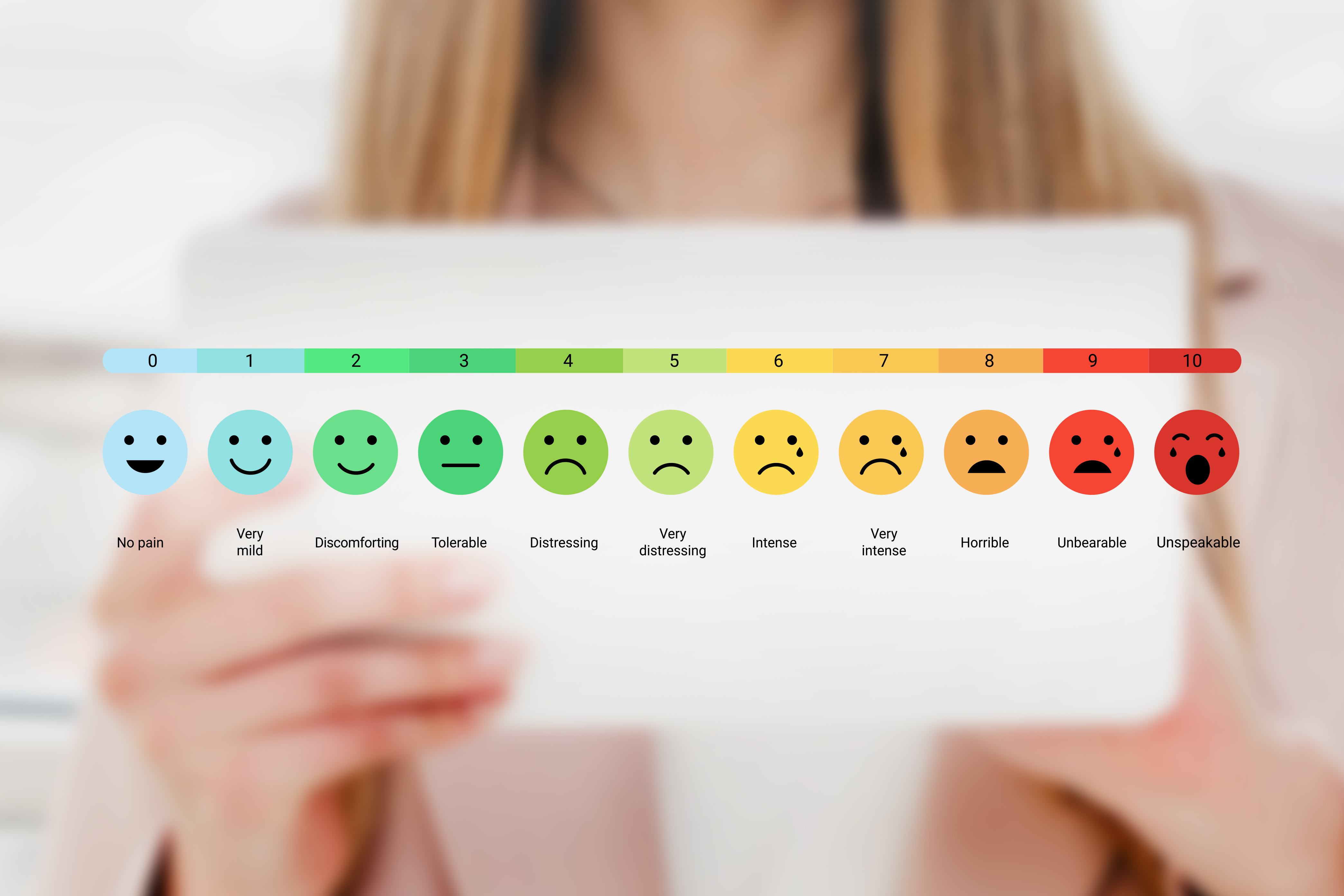How to Use Pain Assessment Tools for Children to Build a Pediatric Pain Care Plan

Key Takeaways
- Assessing pain in pediatric patients is often challenging, and it’s estimated that nearly two-thirds don’t receive adequate pain management.
- Healthcare professionals need to be familiar with pain assessment tools for children that allow them to accurately quantify their experience through observational and self-reported data.
- Using tools like the Visual Analog Scale and the OUCHER Scale to build pediatric care plans requires training for selection, introduction, and application.
Over 5 million children are hospitalized in the United States every year, and approximately 75% are infants. Pain assessment is a critical component of care, but many young patients lack the ability, vocabulary, self-awareness, or confidence to describe and quantify what they’re feeling. As a result, it’s estimated that only 36% of pediatric patients receive adequate pain management, with a high proportion being infants and toddlers.
Pain assessment tools for children provide healthcare workers with structured methods to support pain management and guide care teams toward ideal evidence-based interventions. Continuing education is an essential part of these strategies, and courses like Gentle Healing: Unlocking the Potential of Pediatric Pain Care provide key insights for providing empathetic pharmacological and non-pharmacological treatment.
Here are some of the best pain assessment tools that healthcare professionals are deploying today, and how they support creating pediatric care plans.
The Impact of Pediatric Pain Assessment
Pain in children isn’t just a physical complaint. Acute pain can precipitate an intense state of alarm, while chronic pain that is poorly managed can affect emotional well-being, behavior, and development. Untreated or undermanaged pain can lead to:
- Increased anxiety and fear of medical settings
- Poor sleep and appetite disturbances
- Behavioral issues, including withdrawal or irritability
- Long-term sensitization to pain (chronic pain syndromes)
The reality is that ineffective pain management can lead to significant downstream effects that impact physical and mental health far into adulthood. It’s vital that healthcare professionals accurately assess and manage pain for young patients during these formative experiences with the industry.
Choosing the Right Pediatric Pain Assessment Tool
The gold standard in pain assessment is the use of a self-reported tool, but many children are unable to accurately express their experiences in traditional frameworks. The following tools are designed to empower children of different ages, developmental levels, and clinical contexts to advocate effectively for themselves.
Infants and Non-Verbal Children
- FLACC Scale: This tool allows the clinician to score behaviors based on observations of the child’s face, legs, activity, crying, and consolability. By attaching numbers to these elements, the FLACC scale helps quantify pain severity without verbal confirmation.
- Neonatal Infant Pain Scale (NIPS): This tool relies on an evaluation of a child’s facial expressions, crying, and body movements to generate an estimate of pain severity.
Toddlers and Preschoolers
- Faces Pain Scale: This self-reporting pain scale uses cartoon faces ranging from “no pain” to “very much pain.” The clinician asks the child to select the face that is most like how they feel.
- OUCHER Scale: A self-reporting pain scale similar to the Faces Pain Scale, OUCHER uses pictures of children associated with a numeric rating scale.
School-Aged Children and Adolescents
- Numeric Rating Scale (NRS): Young children are asked to rate their pain on a 0-10 scale with this self-reporting tool.
- Visual Analog Scale (VAS): Scores on this scale are recorded by asking the child to make a handwritten mark on a line that represents a continuum between “no pain” and “worst pain.”
For the most accurate assessment of pain, it’s important to always match the tool to the child’s cognitive ability, not just their age. Healthcare providers will need to rely on experience and training to make an appropriate choice.
Using Pain Assessment Tools for Children
After selecting a tool, healthcare workers will need to take age-appropriate steps to ensure it generates effective responses.
1. Introduce
The first step with pain assessment tools for children is to explain them in age-appropriate language. If a child doesn’t know why you’re asking questions and the importance of answering honestly, they may not give you accurate responses.
2. Observe and Listen
The assessment begins by observing all relevant factors and evaluating the patient’s responses. For infants or non-verbal children, watch body language, crying, and changes in activity. For older children, listen carefully to their self-reported experience and align it with scoring criteria.
3. Record the Score
The pain score should be clearly documented in the medical record. Subjective characteristics like location and what seems to improve pain should also be noted for the care team.
4. Repeat After Intervention
A positive assessment is typically followed by a pain management intervention. Reassessment after intervention is important for measuring its effectiveness. It’s also important to remember that pain is dynamic, and it may increase or decrease in severity for a variety of reasons and without warning.
Building the Pediatric Pain Care Plan
Once pain has been assessed, the next step is translating that information into a personalized care plan. This plan should combine non-pharmacologic strategies tailored to the child’s needs and consideration of medication when appropriate.
Set Pain Goals
Every care plan should include goals that can be measured in response to interventions. For instance, a quantifiable goal could be reducing pain from 7 to 3 within 60 minutes of medication being administered. Longer-term goals may include improving mobility, reducing anxiety, or restoring healthy sleep patterns.
It’s important to remember that “pain-free” is not always a realistic or ideal goal, even for children. Healthcare providers need to carefully weigh practical, social, developmental, and overall health concerns to determine the best balance of medications and alternative pain management strategies. Always engage both the child and parents whenever possible when setting these goals.
Non-Pharmacological Strategies
Although medication is often the most direct way to treat pain, non-pharmacological interventions are often acceptable starting places. These can be just as important as medication and are often well-received by children:
- Distraction techniques: Bubbles, toys, music, or virtual reality
- Relaxation strategies: Deep breathing or guided imagery
- Comfort positioning: Allowing a parent to hold the child during procedures
- Therapies: Physical therapy, occupational therapy, or play therapy for rehabilitation
Pharmacological Strategies
When non-pharmacological strategies aren’t effective, the plan may need to introduce medications to bring pain down to tolerable levels. In many cases, a multimodal approach can be highly effective when prescribed responsibly:
- Mild pain: Acetaminophen or ibuprofen are common starting places.
- Moderate to severe pain: Opioids may be necessary, but doses should be carefully titrated.
- Procedural pain: Consider topical anesthetics or possibly sedation when appropriate. Always tailor dosing to age, weight, and medical history.
Improving Pain Management for Children
Using pain assessment tools for children isn’t just a clinical task—it’s a mechanism for measuring success in managing a child’s care and validating their experiences. When good assessment is paired with a thoughtful care plan, children recover faster, feel safer, and develop trust in healthcare systems.
Premiere is helping healthcare professionals across the industry engage with young patients and develop pain management plans that deliver the best possible experience. Courses like Gentle Healing: Unlocking the Potential of Pediatric Pain Care provide powerful strategies for engaging with children, evaluating their pain, and implementing effective interventions.
All of Premiere’s award-winning courses are created by industry experts and help busy healthcare providers develop their careers and meet their professional obligations from any screen.
FAQs
What is the FLACC pain scale for kids?
The FLACC pain scale allows healthcare workers to score a child’s pain based on observations of their face, legs, activity, crying, and consolability. This tool is primarily used with infants and non-verbal children.
What pain scale is used for kids?
There are several pain scales used for children that vary based on age, developmental level, and ability to self-report. Tools like the Faces Pain Scale use cartoon faces that estimate a child’s experience, and the Numeric Rating Scale relies on a traditional 0-10 scoring system.
What pediatric pain tool is appropriate for adolescents?
The Numeric Rating Scale and Visual Analog Scale are both appropriate for adolescents who are both verbal and developmentally capable of self-reporting.
Latest Posts


.png)
.jpeg)


